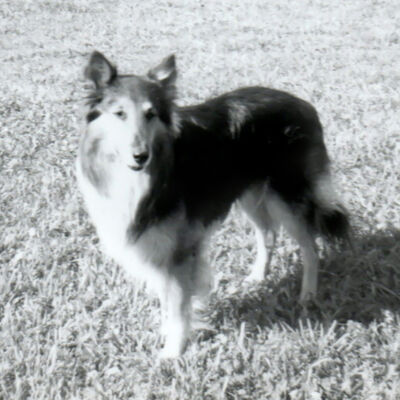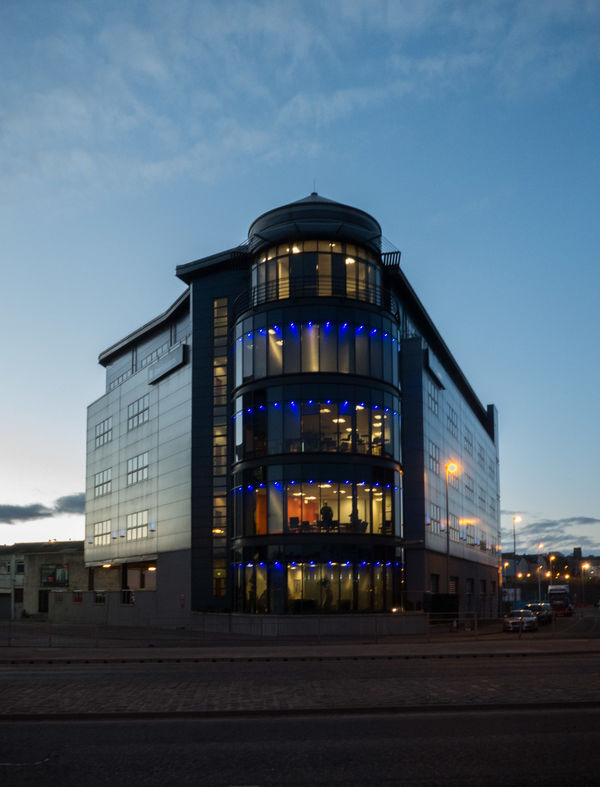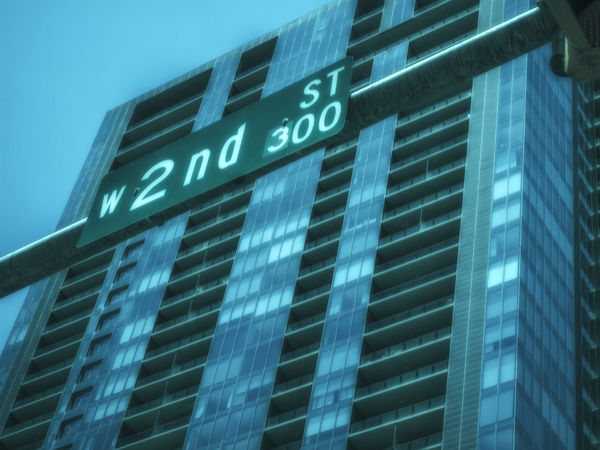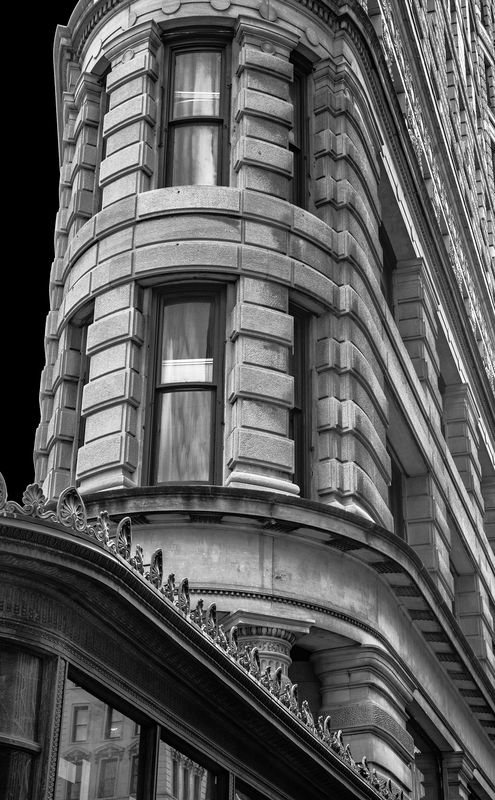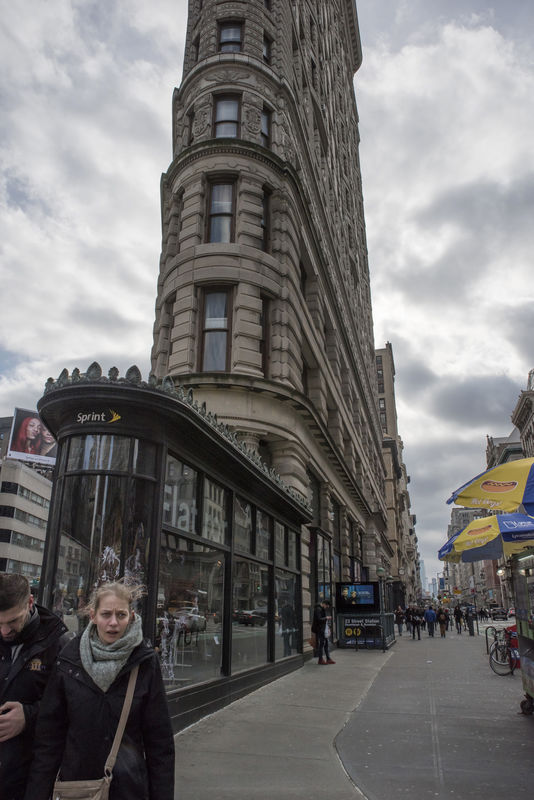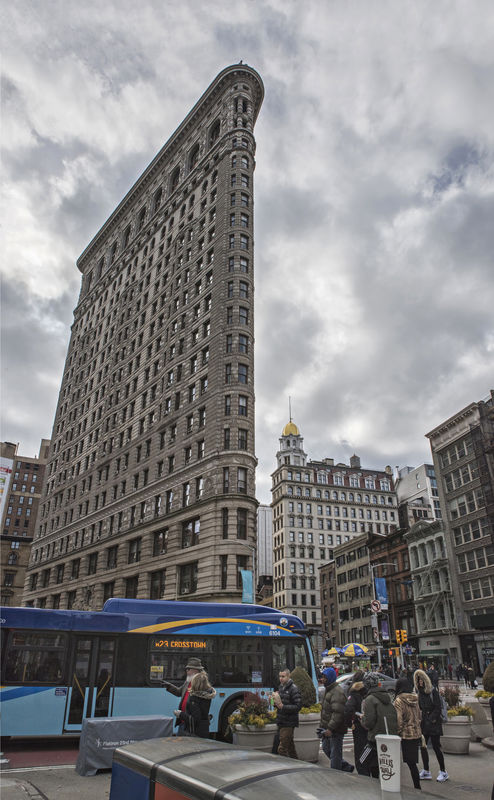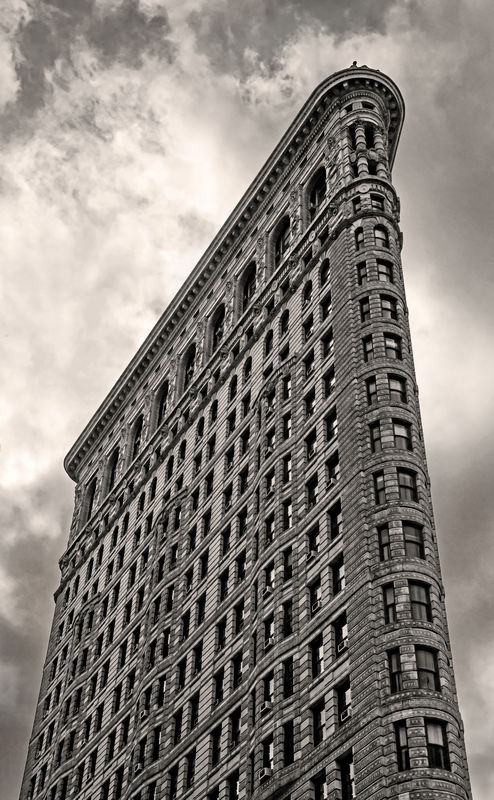Monthly Masters' Critique - March 2021 - Urban Architectural Photography - Abbott's "Flatiron"
Mar 1, 2021 09:20:53 #
Introduction
After last month's rousing discussion of abstract art, we will move to another extreme: deliberate realism. We will look at two examples of urban architectural photography by one of that genre’s earliest masters, Berenice Abbott. Born in Springfield, Ohio, Abbott spent the early part of her artistic career studying sculpture in New York, Berlin, and Paris, where she worked as Man Ray's studio assistant and became interested in the methodical photographic techniques of Eugene Atget. Upon return to the US, she began the body of work she is most famous for: an extensive study of architecture and city life in New York. She was credited with developing the concepts of birds’-eye and worms’-eye POV of cityscapes and buildings.
Abbott took these photos of the Flatiron building in New York in 1938. Abbott’s photographs of the Flatiron demonstrate her principles of documentary photography: it serves as a record for the future and has content, or meaning. But Abbott did not intend her content to express feelings. "People say they have to express their emotions. I’m sick of that." Abbott told an Art News magazine writer. "Photography doesn’t teach you how to express your emotions; it teaches you how to see."
Study these two images of Abbott’s, both featuring the Flatiron building. Share your thoughts about either or both. Below are some questions to spur your thinking. Answer any that strike your fancy.
Questions for Consideration
1. What do you think of these images? What about their compositions? What about the technical considerations? What are the relative strengths and weaknesses? Would you want either of these in your own collection?
2. Which of these two images of the Flatiron building do you prefer? Why?
3. Should architectural/urban photographs tell a story? Does either of these images suggest a story? Does one imply more story than another? Does that story affect the impact on you as a viewer? Explain.
4. The angles of view are very different in these two photographs. The first is closer to the worms’ eye view and the second to the birds’ eye view that are attributed to Abbott’s photography. When you make photographs of city scenes or architecture, do you use either of these approaches? If so, please consider sharing an example of either, or both.
5. Do you agree with Abbott’s contention that photography is about “seeing” rather than “feeling”? Explain your thinking.
Links for Further Study
https://www.icp.org/browse/archive/constituents/berenice-abbott?all/all/all/all/0
https://en.wikipedia.org/wiki/Berenice_Abbott
https://www.moma.org/artists/41
https://huxleyparlour.com/artists/berenice-abbott/
https://www.nytimes.com/2018/06/01/books/review/berenice-abbott-julia-van-haaften.html
https://www.asmp.org/resources/about/history/interview-founders/berenice-abbott/
https://www.6sqft.com/interview-author-julia-van-haaften-on-delving-into-the-life-of-photographer-berenice-abbott/
After last month's rousing discussion of abstract art, we will move to another extreme: deliberate realism. We will look at two examples of urban architectural photography by one of that genre’s earliest masters, Berenice Abbott. Born in Springfield, Ohio, Abbott spent the early part of her artistic career studying sculpture in New York, Berlin, and Paris, where she worked as Man Ray's studio assistant and became interested in the methodical photographic techniques of Eugene Atget. Upon return to the US, she began the body of work she is most famous for: an extensive study of architecture and city life in New York. She was credited with developing the concepts of birds’-eye and worms’-eye POV of cityscapes and buildings.
Abbott took these photos of the Flatiron building in New York in 1938. Abbott’s photographs of the Flatiron demonstrate her principles of documentary photography: it serves as a record for the future and has content, or meaning. But Abbott did not intend her content to express feelings. "People say they have to express their emotions. I’m sick of that." Abbott told an Art News magazine writer. "Photography doesn’t teach you how to express your emotions; it teaches you how to see."
Study these two images of Abbott’s, both featuring the Flatiron building. Share your thoughts about either or both. Below are some questions to spur your thinking. Answer any that strike your fancy.
Questions for Consideration
1. What do you think of these images? What about their compositions? What about the technical considerations? What are the relative strengths and weaknesses? Would you want either of these in your own collection?
2. Which of these two images of the Flatiron building do you prefer? Why?
3. Should architectural/urban photographs tell a story? Does either of these images suggest a story? Does one imply more story than another? Does that story affect the impact on you as a viewer? Explain.
4. The angles of view are very different in these two photographs. The first is closer to the worms’ eye view and the second to the birds’ eye view that are attributed to Abbott’s photography. When you make photographs of city scenes or architecture, do you use either of these approaches? If so, please consider sharing an example of either, or both.
5. Do you agree with Abbott’s contention that photography is about “seeing” rather than “feeling”? Explain your thinking.
Links for Further Study
https://www.icp.org/browse/archive/constituents/berenice-abbott?all/all/all/all/0
https://en.wikipedia.org/wiki/Berenice_Abbott
https://www.moma.org/artists/41
https://huxleyparlour.com/artists/berenice-abbott/
https://www.nytimes.com/2018/06/01/books/review/berenice-abbott-julia-van-haaften.html
https://www.asmp.org/resources/about/history/interview-founders/berenice-abbott/
https://www.6sqft.com/interview-author-julia-van-haaften-on-delving-into-the-life-of-photographer-berenice-abbott/
fair use: https://collections.mcny.org/Explore/Highlights/Berenice%20Abbott/?gclid=Cj0KCQiAvvKBBhCXARIsACTePW8KrxG3yyHrG-39GJaZOkmx1luvlPc9yQNTOUujHkqH2GZE8ZYUG88aAudjEALw_wcB
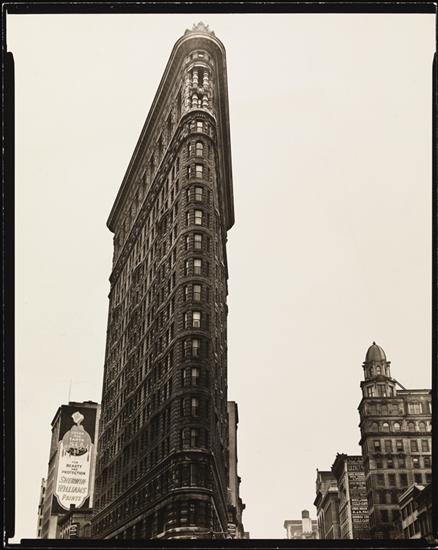
fair use:https://collections.mcny.org/Explore/Highlights/Berenice%20Abbott/?gclid=Cj0KCQiAvvKBBhCXARIsACTePW8KrxG3yyHrG-39GJaZOkmx1luvlPc9yQNTOUujHkqH2GZE8ZYUG88aAudjEALw_wcB
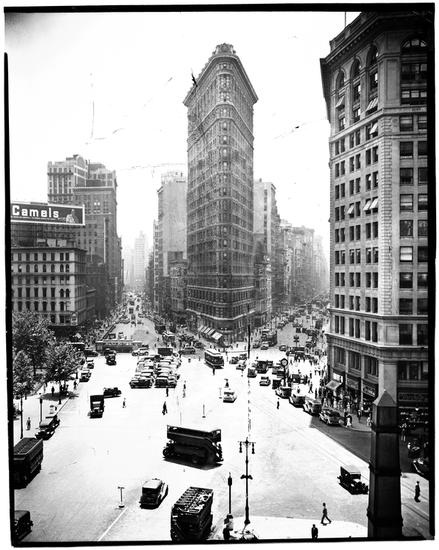
Mar 2, 2021 08:28:07 #
These photos are indeed thought-provoking, given your parameters here.
So, to answer the questions:
First, I don’t think one can rally compare the compositions because the photos have completely different purposes, to me at least.The first is a portrait, so to speak, of the building, while the second is a sort of microcosm of the city which happens to include the building.
Second, which do I prefer? That’s a tough question because, as stated before, they serve very different purposes. If pinned down, I suppose I’d have to choose th second because the microcosm is a bit more interesting than the portrait.
Third, as to storytelling, of course not. I have never felt that photos need to tell a story. Some of mine do, but the story is incidental to the impact of the photo. My post here today is that of a sunset I consider beautiful. There’s no story in it, but viewers seem to be enjoying it anyway. Action photos do, I suppose, need a story, but others do not.
Close in or far away? That’s entirely personal preference. Mine here is far away, but others could choose close-in for very legitimate reasons.
Seeing or feeling? To me, seeing. I have never felt the need to feel something in order for a photograph to be good. That just doesn’t make sense--to me, at least.
There you have it. I’m sure others may vehemently disagree, and that’s ok.
So, to answer the questions:
First, I don’t think one can rally compare the compositions because the photos have completely different purposes, to me at least.The first is a portrait, so to speak, of the building, while the second is a sort of microcosm of the city which happens to include the building.
Second, which do I prefer? That’s a tough question because, as stated before, they serve very different purposes. If pinned down, I suppose I’d have to choose th second because the microcosm is a bit more interesting than the portrait.
Third, as to storytelling, of course not. I have never felt that photos need to tell a story. Some of mine do, but the story is incidental to the impact of the photo. My post here today is that of a sunset I consider beautiful. There’s no story in it, but viewers seem to be enjoying it anyway. Action photos do, I suppose, need a story, but others do not.
Close in or far away? That’s entirely personal preference. Mine here is far away, but others could choose close-in for very legitimate reasons.
Seeing or feeling? To me, seeing. I have never felt the need to feel something in order for a photograph to be good. That just doesn’t make sense--to me, at least.
There you have it. I’m sure others may vehemently disagree, and that’s ok.
Mar 2, 2021 12:11:08 #
jaymatt wrote:
These photos are indeed thought-provoking, given y... (show quote)
Thanks for jumping in first with some thoughtful comments.
I think there’s a lot of different reactions to the notion of “story”. I’m a waffler on that concept. I love images that cause me to imagine a story, but I don’t always think of what story I’m trying to tell when I capture an image, I’m more often just responding to the visual.
Mar 3, 2021 08:55:36 #
The first I don't like at all. It's just a building sticking up in the sky from who knows where. Not sure who would like it, it looks simply like a photo showing a certain building style, not something you would look at for pleasure.
The second I like the composition, which I think is great. You know what you're looking at, and I guess it tells a story, but don't ask me what the story is. I never see the "story." To me, it's just a picture of a street with people moving about, and an unusually shaped building.
I think the exact same shot with modern equipment and a decent photographer would be super. He got the hard part right, the composition, the technical stuff is nasty, I guess mostly due to equipment issues. People always say it's not the equipment, but the shooter... Sometimes I reckon, but equipment often "tells the story."
The second I like the composition, which I think is great. You know what you're looking at, and I guess it tells a story, but don't ask me what the story is. I never see the "story." To me, it's just a picture of a street with people moving about, and an unusually shaped building.
I think the exact same shot with modern equipment and a decent photographer would be super. He got the hard part right, the composition, the technical stuff is nasty, I guess mostly due to equipment issues. People always say it's not the equipment, but the shooter... Sometimes I reckon, but equipment often "tells the story."
Mar 3, 2021 10:41:25 #
To my way of thinking, all photographs tell a story one way or another, even if it's just the photographer saying "I think this deserves your attention". IMO in both of these the "story" is the unusualness of the building, and while #1 does a good job of accentuating that unusualness, in #2 the story includes showing that it's the streets that partly determined the unusual shape.
I think Berenice Abbott would have made excellent use of drones if they'd been available and if she'd had something other than a large format view camera to work with. #2 would be so much better if it'd been taken from the point where the centreline of both streets intersect, giving a line of sight that included an unobstructed view of both streets. As it is the building on the right intrudes, and while it doesn't ruin the shot, it's resulted in a less than optimum shot.
I agree with her assessment that photography is primarily a visual medium which has the potential to change how we see - something it has in common with other forms of visual art. As such, photography has the potential to evoke all sorts of things apart from feelings, such as interest, curiosity, insight and even has the potential to alter our state of mind. It also has the potential to inform and educate intellectually as well as emotionally.
Put another way, photography has the potential to be both left brain and right brain oriented. Emotional involvement with a photo may be one of the more intense possibilities, but it's a long way from being the only possibility, and it's easy to exaggerate how much value emotional responses have.
I was inspired to take the shot below by the unusualness of the building, which includes not only its shape but also its appearance (it's black and shiny with blue lights - how much of an explanation does it need? )
)
.
I think Berenice Abbott would have made excellent use of drones if they'd been available and if she'd had something other than a large format view camera to work with. #2 would be so much better if it'd been taken from the point where the centreline of both streets intersect, giving a line of sight that included an unobstructed view of both streets. As it is the building on the right intrudes, and while it doesn't ruin the shot, it's resulted in a less than optimum shot.
I agree with her assessment that photography is primarily a visual medium which has the potential to change how we see - something it has in common with other forms of visual art. As such, photography has the potential to evoke all sorts of things apart from feelings, such as interest, curiosity, insight and even has the potential to alter our state of mind. It also has the potential to inform and educate intellectually as well as emotionally.
Put another way, photography has the potential to be both left brain and right brain oriented. Emotional involvement with a photo may be one of the more intense possibilities, but it's a long way from being the only possibility, and it's easy to exaggerate how much value emotional responses have.
I was inspired to take the shot below by the unusualness of the building, which includes not only its shape but also its appearance (it's black and shiny with blue lights - how much of an explanation does it need?
 )
).
Mar 4, 2021 10:14:44 #
BigDaddy wrote:
The first I don't like at all. It's just a buildi... (show quote)
I share your preference for the second, because for me it does have story which for me is simply a keyhole view into life of the 1930s in NY. And yes, it is hard to judge technical considerations in these older photographs, we have to find ways to “look around” the shortcomings of their equipment. I found myself wishing I could see photos of her dragging all that stuff up to the place she set up for that second image.
Mar 4, 2021 10:17:36 #
R.G. wrote:
To my way of thinking, all photographs tell a stor... (show quote)
Thanks for such a thorough and thoughtful review.
And for offering up one of your own images for review. I’ll try to do the same.
You make a great point of how drones have changed the options for perspective on birds-eye views. Before drones photographers were limited to higher viewpoints offered by other accessible buildings.
Mar 11, 2021 06:49:02 #
minniev wrote:
I think there’s a lot of different reactions to the notion of “story”. I’m a waffler on that concept. I love images that cause me to imagine a story, but I don’t always think of what story I’m trying to tell when I capture an image, I’m more often just responding to the visual.
I think there’s a lot of different reactions to the notion of “story”. I’m a waffler on that concept. I love images that cause me to imagine a story, but I don’t always think of what story I’m trying to tell when I capture an image, I’m more often just responding to the visual.
The story of a photograph can be quite explicit and easy to detect, as is the case with journalistic or documentary photography. But oftentimes it's not a narrative type of story that a photograph tells.
With these photos, Abbott had dedicated herself to what would become her best-known project, "Changing New York" (1935-39). Commissioned by the Roosevelt administration as part of its response to the nationwide economic crisis, Abbott saw the enterprise as both a way of documenting the City and as a personal work of art.
In 1938, hoping to take advantage of the fifty million visitors expected at the New York World’s Fair of 1939, the publisher, E.P. Dutton, offered to bring out a selection of one hundred images from the project accompanied by a text by the renowned art critic Elizabeth McCausland, who also happened to be Abbott’s life partner. Eventually, the book turned out to be more of a tourist guide, and McCausland's text was edited down to bare information about the various buildings. The original captions, however, do tell quite a story.
The Flatiron Building, while being a source of pride for New Yorkers when it was built in 1902, was also a source of anxiety, since people felt it was unstable and likely to fall down at any moment. McCausland captures this in her text, which did not get published: "Staggering before the onslaught of the buses, taxis and motor cars which unceasingly pour down Fifth Avenue and Broadway to converge at the Flatiron Building, it seems about to topple over, a modern Tower of Pisa. The emotion generated by its precarious attitude is amusing and also a little terrifying, as if the denizen of the city realized but would not confess the frailty and impermanence of its structures."
Of the two photos, the first, to me, tells this story more than the second, paradoxically because it doesn't include the traffic mentioned in the caption. The prominent building, bold and assertive, is also strangely vulnerable due to its angle and that of its diminutive neighbor with the paint sign.
The worm's-eye-view of the first image fortifies this impression. What little architectural photography I do always has this point of view, probably because I'm too lazy to climb a lot of stairs, or too cheap to hire a helicopter.
Here's one of my images that tries to tell the story of a dialogue, or is it an argument, between an office building and a humble street sign.
Mar 11, 2021 20:05:17 #
jburlinson wrote:
The story of a photograph can be quite explicit an... (show quote)
Thanks for a rich offering with so much extra information about Abbott and the Flatiron building, much of which is new knowledge that I didn’t find. I appreciate that so much!
Mar 12, 2021 13:27:38 #
minniev wrote:
b Introduction /b br After last month's rousing ... (show quote)
I would tend to favor the second shot, if I were to pick one. For me it is far more interesting, in that its showing a place in time. Except for the AC units, the first one could have almost been taken yesterday. What I can relate to, is the how to shoot it. Several years ago, I accompanied a friend to deliver something many blocks to the south, and we walked up to see it. I remember being fairly perplexed about how to try and capture as I wanted to. Far enough away to view the entire building, reduced the interesting architectural details of the building itself, as well as the surface textures. So I wondered to and fro, a shot here and there. I was also exposing for the sky, so when I found this folder, I remembered that in all my shots, everything not sky was black, and the sky was close to having blown areas. Its taken me some time to make a few of these at least presentable. It would have been terrific to have gotten that birds-eye view. Maybe these shots will be of some interest. And thank you for another interesting topic. This one turned into a bit of a project for me.
Mar 13, 2021 10:37:04 #
fergmark wrote:
I would tend to favor the second shot, if I were ... (show quote)
Thanks, Mark, for this very special contribution with actual photos of the building and a description of the challenges of photographing it! The contrast, the form factor, the converging verticals that would be inevitable with most cameras, the choices between capturing detail and capturing the whole thing. Nicely “rescued” from the shooting challenges!
If you want to reply, then register here. Registration is free and your account is created instantly, so you can post right away.


